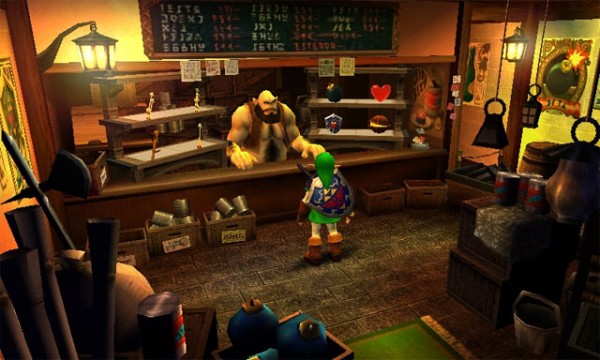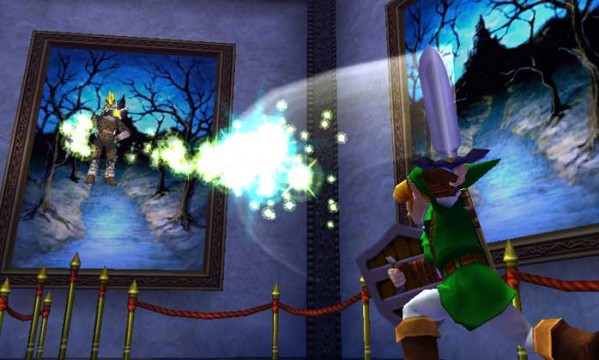Improved visuals, timeless gameplay, immersive 3D effects, classic soundtrack
Graphical inconsistencies, Master Quest not available from the start
It seems almost a little ironic that Nintendo is hedging its bets on a thirteen-year-old game to energize sales of its new 3DS platform, but considering the title in question, it shouldn’t come as much of a surprise. The Legend of Zelda: Ocarina of Time, even a decade after its initial release, is consistently ranked among the greatest achievements in the video game industry by fans and critics alike, and that it is being remade for the company’s fledgling handheld immediately imbues the console with a hardcore credibility. Rather than reimagine the entire experience, Nintendo and co-developer Grezzo have opted instead to give the game a complete visual overhaul, making it more palatable to an audience weaned on bleeding-edge technology and photorealistic graphics. The end result is a conservative update to one of the finest titles ever created, but as replaying this classic adventure so convincingly proves, any further changes would have been largely unnecessary– the game remains just as engaging as when it was first released, eluding the phantom specter of time through expert focus and sharp design.
In fact, it is almost astonishing just how well the core experience holds up considering its age. Recent Zeldas, particularly Wind Waker and Twilight Princess, seem to suffer from something of an identity crisis, caught between a desire to break free from Ocarina of Time’s shadow and an obligation to acknowledge its influence. As a result, both games are ultimately held back by their reluctance to stray too far from their roots, and as successful as they may be on their own merits, they invariably fall short when compared to their Nintendo 64 ancestor. Ocarina of Time, even some thirteen years after the its initial release, is not mired by such problems– there is a certain purity to the game’s vision that is almost difficult to describe, but it shines through in how deftly balanced the entire adventure is. This can simply be attributed to the fact that the title was effectively the first of its kind, but that would be undermining just how effortless it seems in light of the adversity it faced; after all, the Zelda series was already well-established at the time of Ocarina’s development, and the pressure to uphold its standards (especially on the heels of A Link to the Past and Link’s Awakening, two veritable classics of the medium) must have been astronomical. You would never be able to guess it from playing Ocarina of Time, though– the game exudes such confidence that it’s difficult to imagine any uncertainty was running through the developers’ minds when they were crafting it, exploring as they were the new frontier of three-dimensional game design.
This translates into an experience that is largely able to weather the test of time with grace, falling short only with regard to its visual presentation (which this remake exists to rectify). Indeed, save for the improved graphics, nearly every facet of Ocarina of Time 3D is identical to its source material: great pains have been taken to replicate the original’s soundtrack (though it is easy to assume Grezzo left it untouched, so close does it come to achieving this goal), and the entirety of the in-game text (with the exception of a few new lines relating to the added hint stones) has been lifted verbatim from the Nintendo 64 classic. This may prove to be disappointing for fans who were hoping to see a new dungeon or some other piece of additional content, but it only further illustrates how such changes would conflict with the intentions behind this remake. Ocarina of Time 3D is very much a testament to the original’s legacy, even going so far as to include all of the (non-detrimental) glitches found in that game. Its very existence is an act of fan service, and the object here was not so much to recreate Ocarina of Time as it was to update it. No longer is the title a product of its time; now it can stand comfortably alongside modern releases and contemporary gamers would be none the wiser.

From the ground up, Ocarina of Time has been made over to better reflect the industry’s current technological sensibilities. All of the game’s assets have been completely redone, from the textures that comprise the four corners of Hyrule to all of the virtual inhabitants (along with their accompanying animations) living therein. As breathtaking as each of these individual enhancements may be, most remarkable are the small visual touches interspersed throughout the game. Ocarina of Time 3D is certainly beautiful by any standards, but it is the attention to detail that really makes the title a sight to behold. The way the first rays of sunlight filter over the landscape, the miscellaneous furnishings in the various households– all of these little flourishes, as insignificant as they may seem compared to the redone textures and the improved character models, contribute immensely to the sense of immersion so palpable in the game, and they go a long way in bringing Hyrule to life.
Also quite stunning is the title’s use of 3D. Ocarina of Time lends itself surprisingly well to a stereoscopic display, so much so that certain instances would seem like they were custom made for 3DS had they not been present in the original game. It is true the effects are largely inconsequential to the actual gameplay, but that was to be expected– the title was developed long before 3D was feasible in an interactive medium, and as such it was not designed to utilize the effects in more than a superficial manner. If anything, Ocarina of Time 3D actually seems to benefit from their nonnecessity: the game is still enjoyable even with the effects completely turned off, but it also offers an added level of engagement to those who do choose to experience it in all of its stereoscopic glory. Much in the way rumble enhanced the sense of immersion in the original game, so, too, do the 3D effects in this portable remake, drawing you into the adventure in a way never before possible.
Unfortunately, the game’s visuals are not entirely impeccable. While the character models have indeed all been improved, many– particularly Ganondorf’s– seem only marginally so, sporting no where near the level of detail as Link’s redesign. They are still far and away superior to anything found in the Nintendo 64 title, but these inconsistencies are nonetheless a little disheartening to see, especially considering 3DS is capable of so much more. There are also a few instances where the framerate dips beyond comfort, often in rooms teeming with enemy creatures. These moments occur infrequently enough that they aren’t all that much of a bother, but their general presence is yet another curiosity given the relative strength of the platform.

Despite my earlier insistence that the game is almost identical to the Nintendo 64 classic, the title is not entirely devoid of new content: the primary adventure is supplemented with a mirrored Master Quest, featuring stronger enemies in addition to the remixed dungeons for which the mode is infamous. While difficult in its own right, it is the mirroring in particular that makes this quest a beast of a different nature, providing an ample challenge to even the most ardent of Zelda fans. In fact, the game’s only real fault is that this mode is not available from the outset (much as it was in Wind Waker’s pre-order disc). Ocarina of Time proves to be a lengthy adventure even when you already know what to do, and having to play through it once entirely just to unlock Master Quest can be an exhausting task. This, admittedly, is only a minor annoyance, but having immediate access to the title’s new content would have been a welcome option, especially as many gamers (myself included) have already experienced the original adventure a number of times before 3D’s release.
Still, this niggling complaint does little to detract from the overall product. Ocarina of Time 3D succeeds largely because it does not tamper with the original title, striking the perfect balance between old and new content. The improved visuals sufficiently modernize the entire experience for a contemporary audience, while the enhanced Master Quest mode offers up a significant challenge to even veteran fans of the series. Those who did not like the game in its original incarnation will likely not be swayed by this updated package, but everyone else will no doubt be taken anew by its timeless magic.




 ShareThis
ShareThis







Good review, Kevin.
I’ve been through various incarnations of OoT more times than I can remember, and I tore through the “main mode” of this 3D version, almost too quickly.
Then, something really interesting happened. As I’ve been playing through Master Quest, I’ve been taking my time. I’m enjoying it as a new game. When I run across mirrored Hyrule Field and the music goes calm as the sun sets, I forget what heart piece or item I’m after and just soak in the moment.
I’ve put in some decent hours fishing, and I’ve taken the dive (you know the one) several times just for fun, but the fact that the game is so damn good that I sometimes just stop and breathe it in, to me means that Nintendo and Greezo nailed it. The adventure feels the same today as it did in 1998, which is pretty amazing.
Thank you very much. :D
I know exactly what you mean. Every time the sun would either rise or set I’d go into the first-person viewpoint and just enjoy the scenery. Hyrule can be absolutely breathtaking at times, which is especially amazing considering how familiar it has become over the years and various playthroughs. The developers did a wonderful job breathing new life into the game, and that it is able to evoke such awe despite being so similar to the original is a testament to their success.